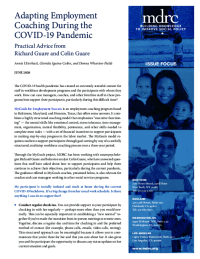Adapting Employment Coaching During the COVID-19 Pandemic
Practical Advice from Richard Guare and Colin Guare

The COVID-19 health pandemic has created an extremely stressful context for staff in workforce development programs and the participants with whom they work. How can case managers, coaches, and other frontline staff in these programs best support their participants, particularly during this difficult time?
MyGoals for Employment Success is an employment coaching program based in Baltimore, Maryland, and Houston, Texas, that offers some answers. It combines a highly structured coaching model that emphasizes “executive functioning” — the mental skills like emotional control, stress tolerance, time management, organization, mental flexibility, persistence, and other skills needed to complete most tasks — with a set of financial incentives to support participants in making step-by-step progress in the labor market. The MyGoals model requires coaches to support participants through goal-setting by way of a carefully structured, multistep workforce coaching process over a three-year period.
Through the MyGoals project, MDRC has been working with neuropsychologist Richard Guare and behavior analyst Colin Guare, who have answered questions that staff have asked about how to support participants and help them continue to achieve their objectives, particularly during the current pandemic. The guidance offered to MyGoals coaches, presented below, is also relevant for coaches and case managers working in other social services programs.
My participant is socially isolated and stuck at home during the current COVID-19 lockdown. It’s a big change from her usual work schedule. Is there anything I can do to support her?
- Conduct regular check-ins. You can provide support to your participant by checking in with her regularly — perhaps more often than you would normally. This can be especially important in establishing a “new normal” together if you’ve made the transition from in-person meetings to remote ones. Together, discuss a regular day and time for checking in and the preferred method of contact (for example, phone calls, emails, video calls, texting). This structured approach can be meaningful because it allows you to communicate that you’re there for her and that you care about her. It also gives you and the participant the opportunity to discuss any status updates on her current situation and goals.
- Encourage creating a daily schedule of activities and tasks. In the short term, you can also suggest that your participant add more structure to her days by developing a daily schedule. This can be especially helpful for participants who have become unemployed or may be stuck at home. Encourage her to start out small and focus on scheduling and setting aside time for pleasant activities (like watching a light-hearted TV show, calling a family member or friend, or pursuing a hobby). By creating structure and intentional time for enjoyable activities, she can begin to feel more control over what might seem like an overwhelming stretch of time. With that sense of control, she can gradually schedule more tasks into her days.
My participant and I always used to meet in person and now we are adjusting to meeting on the phone. How can I help make this transition smooth?
- Create an agenda together. Working on an agenda together can help establish priorities for both of you during your meeting. Invite your participant to set the agenda for your meetings to cover the topics he wants to talk about and how much time he wants to spend discussing each topic. This approach will help you remind him about the direction of the conversation if it veers off-course. Remind your participant of how much time he has allotted for each topic and stick to that.
- Set clear boundaries. Remind your participant what you can help with and what is beyond your knowledge or area of expertise. For example, you may need to remind your participant that you can’t offer legal or psychological advice, but you can direct him to helpful resources or supply referrals.
My participants are having trouble working toward self-directed goals that they set before the COVID-19 pandemic settled in. How can I continue to provide support and encouragement at this time?
- Create smaller steps. Supporting your participants with goal setting may look different right now. It may not be possible to make progress on certain employment or financial goals during the pandemic. One coaching strategy is to make goals more achievable by breaking down original goals into smaller steps. Perhaps a participant originally set a goal to pay off his student debt, but now the cost and the process feel too daunting. Instead, help the participant modify his goal by setting a more modest goal — for example, to pay off $25 every month. To crystalize the next steps in the participant’s mind, ask him to walk you through the process of making his first payment.
- Focus on immediate needs. In the short term, don’t worry about keeping participants focused on their preexisting goals. Instead, shift your sessions to focus on their immediate needs. Your participants may get caught up in what they think you want to hear; it’s your job to remind them that you are here to support them no matter what. Here are some things you can say to help them reframe their thinking:
- “Let’s put this goal on the back burner for the moment and focus on things that are more important to you right now.”
- “What’s something that’s coming up in the next two weeks that you need or would like to work toward?”
- “What do you need to make progress on this new goal?”
- “Can you walk me through the first step? What do you need to do first?”
My participant is having trouble accessing and paying for her medication. Is there anything I can do?
- Help make contact. The participant may be negotiating her way through several entities and people such as pharmacies, doctors’ offices, and insurance companies to get access to medication. Consider whether it would be appropriate to help her make direct contact with the appropriate point people or, in some cases, make contact on her behalf.
- Explore resources for obtaining low-cost medications. Several online resources are available for finding low-cost prescription medications. They include, for example, an online database comparing prescription drug prices to find the lowest cost; a directory of free and low-cost medicine programs; and a free patient assistance program to help people obtain critical medications. Depending on your participant’s access and level of comfort with technology and the internet, you may want to walk her through these types of resources or explore them on her behalf. Your program should decide which online resources work best for your participants.
Some of my participants are worried about working in an unsafe environment. How can I help them make informed decisions about whether to continue working?
- Have a conversation about “goodness of fit.” Some participants are balancing difficult and conflicting priorities in deciding whether to stick with a job or not. It can be empowering for participants to discuss how well their needs and priorities fit with their current job and what conditions they might want in their next job. You can help participants figure out what kinds of conditions they are willing to accept and at what point they would take action in the face of intolerable working conditions. Consider questions like: At what point would I look for another job? At what point would I raise concerns about an uncomfortable working condition with my employer? When is the current job no longer a good fit? This conversation can also give you a better understanding of a participant’s priorities and preferences. In having these conversations, you are helping participants arm themselves with decision-making skills that will be useful in navigating the fast-changing labor market.
- Document their efforts. Encourage participants to document employer responses to questions they raise about personal safety, working conditions, or equipment. If the employer created conditions in which employees can prove they are not safe, it may be possible to get a “constructive dismissal” designation, which applies when working conditions are so intolerable or adverse that employees can argue they have no reasonable alternative but to quit.[1] In addition, encourage participants to document their efforts at requesting personal protective equipment (and other necessary workplace protections) and how the employer has responded so they have a record should they need it in the future.
My participant is interested in applying for Supplemental Nutrition Assistance Program (SNAP) or unemployment insurance (UI) benefits. How can I provide support?
- The process to apply for public benefits varies greatly from state to state. Obtain and share information with participants about accessing SNAP and UI eligibility requirements, especially updated or new information in the wake of new state and federal policies during the pandemic. Become knowledgeable about reputable sources of information, such as government websites, and other widely respected and credible organizations. Try to identify best practices for applying. Participants may, for example, be more successful if they apply online and during certain off-peak hours like evening or early morning.
My participant and his family share one computer at home. How can I help him make progress with his online job search when his time with the computer is very limited?
- Help the participant set a family schedule and identify times when each household member will use the computer. This can help the participant continue to work toward his employment or educational goals from home, such as continuing an online job search. You can also locate and share resources for free or low-cost computers.
My participant’s loved one passed away recently; how do I support her through the grieving process?
- Give her time to react. Let the participant know you hear her and give her time to fully express her emotions. You may feel an urge to pivot into a more action-oriented conversation, but it’s important to provide the safe space for your participants to feel heard and supported before moving on to another topic.
- Practice reflective listening. This strategy allows the participant to reflect more about her range of feelings and helps to keep from projecting our own reactions and experiences onto her situation. Although it can be uncomfortable, sit with the silence; this may give the participant the opening she needs to speak more openly and feel more comfortable with you. Here are some suggested prompts for being a reflective listener:
- “Tell me more about how you’re feeling.”
- “Tell me more about what this person has meant in your life.”
- Reflect the participant’s own words back to her. For example, “It sounds like you relied on [name of loved one who passed away] for support and guidance” or “It seems like this has had a big impact on you.”
In sum, the pointers above should be useful to staff from a variety of social service programs in their efforts to support participants and help them progress toward their goals, particularly during times of crisis. These techniques are intended to offer guidance to coaches and case managers as they help participants tackle challenging scenarios like social isolation, remote communication, setting and working toward goals, accessing and affording medication, making decisions about workplace safety, applying for public benefits, working from home, and dealing with grief — now and in the future.
[1] For more information, see https://thelawdictionary.org/constructive-dismissal/.






